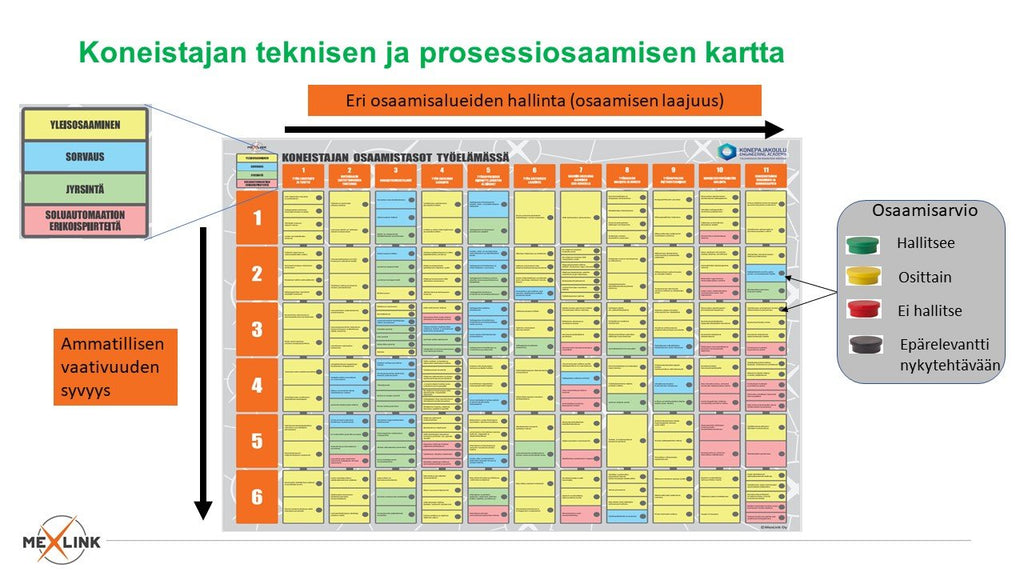Machinist's path - solutions to the skills shortage
Posted by PASI JULKUNEN

We are worried about the lack of talent, but the old methods seem toothless. The attractiveness of the field is not great and the images of work practices are mostly outdated. The real situation will be that the departure cannot be replaced by the thinning number of young people alone and on the other hand by the import of talent that has ended up in fierce international competition (Figure 1). The trade union of machinists represents a very high skill profile. Imaginations that anyone can be trained as a machinist are baseless.

Figure 1. Exit trend in different occupations in Pirkanmaa (Foresight project of the city of Tampere, Konepajakoulu 2.0)
The public authorities, at least at the level of communication, have been enthralled by the miracle of digitization and believe that technology will replace professional people. The hands seem to be swinging harder and harder in the digital hump, which seems to solve everything. Perhaps, however, it has been overlooked that even the top companies in industry do not believe that they can survive without skilled people.
Let's get to the means. It's still worth branding metal professions and companies really need to catch up with the blanks applying for training - in time! Many companies have already drifted into a multilingual environment, and cooperation with recruitment companies just needs to be deepened. Then there remains the third force, i.e. those who are currently employed and have just started their career there. New entrants to the field will also be introduced by the more experienced! Shortening the path of those who have just received training to the productivity needed by the company is one of the educational paths of working life, and the other is to deepen the skills of current professionals. This is, for example, in the subcontracting industry, flexibility with regard to different machines or the ability to manage a broader automation concept.
With a smaller population, we should produce more and respond more flexibly to fluctuations in demand. How can the productivity trick be implemented? Cell automation, intelligent production control and investments in them require time as a strategic measure and also special expertise in driving up new technology. Making work more efficient with modern machinery again depends on professional skills and motivation. The future of mechanized industry requires both investments. It is a struggle for survival in which smaller companies will inevitably fail – those that are unable to increase their skills (Figure 2). The structure of micro-companies (those employing 1-4 people represent 68-73% of cutting-working companies, Statistics Finland) is challenging, and professionalism is a key success factor (specialized expertise, flexibility, low price). On the other hand, the rest of the companies have great potential for development if they have the skills to engage in systematic development work.

Figure 2. Structure of Finnish machining companies (Source: Statistics Finland)
In the ÄVE project ( https://www.mexlink.fi/pearls/som5xcawhxynahom98aerasgf3yhm4 ) we created a foundation for the development of machine shop expertise, the task of which was to revive withering manufacturing expertise. It succeeded in creating a platform for growth, especially for competence concepts in both grinding and machining.
In the Mechanical Engineering School 2.0 project, we once again created a power link between companies and trainers. It revived an old successful concept, which was developed with the spices of the current situation. Management was transferred to SMEs, where the vast majority of those trained in basic metal trades end up. I am particularly proud of the final result ( https://konepajakoulu.fi/ ). Now there is a sticking point for practical knowledge! Peer Haataja took up the challenge and is taking the change forward with TAKK and Tredu, but the concept will certainly expand to other training units as well, because the role of Konepajakoulu is to link the needs of companies and training and cooperation to blow in the same direction. Mechanical engineering schools will certainly be established in places other than Pirkanmaa. Influence must be sought - just empty speeches and Powerpoints are not enough! (Figure 3).

Figure 3. Competence maturation outlined with the help of competence maps
Machining skills were first honed with Sacometalli, whose management took MexLink's service with the ÄVE project. Together with Nillo Adlin, we mapped the silent and invisible side of expertise using the Lönnrot method, i.e. "map the disappearing folklore with your feet tarred". That is, to ask for silent information among machinists and foremen. We got the competence model described for the first time. In the project, Competence Map 1.0 was developed based on Sacometall's machines, the challenge of bronze and the demanding level of dimension management. For this, a big thank you to the people at Sacometall, who also made it possible to generalize the information to other machine shops. Special thanks to Ilari Kinnuse, Mikko Niemin and Samuli Valkama, who brought the realities of an SME as a spice on top of the knowledge elements.
The experience base gathered from the mechanics began to be enriched through practical theory, where expertise was found by the old emeritus fastener wizard Aarre Lehtimäki. Aarre's works on machining stemming from machine shop practices were the seed for our theoretical foundation and, of course, his creative contribution to the development of the competence map. The name of the basic work is Aarrearkku and describes well its value as a link between theory and practice. Peer Haataja, the director of the mechanical engineering school, took up the matter and arranged funding for the testing of the model. We supplemented the competence picture from different areas of expertise: machining from Sandvik Coromant and programming secrets from TAMk's Joni Niemi. We also included Eero Kumanno from Riemu Design, who represents top Finnish design, who visualized the first version of the map collected in Excel (Competence Map 2.0).
In addition to the signatory, Olli Haavisto, who has strong manufacturing management experience and an understanding of the depths of machining, participated in the testing phase from MexLink. ST Koneistus and Tasowheel, as progressive machine shops, took up the challenge given by Peer, both as members of the Konepajakoulu board and because of a burning interest in the subject. Many may wonder why these two are involved in many things, but it is natural for pioneers and achievers. The level of maturity in business development enables more than drowning in daily operations - namely building the future.
We ended up with a visual, i.e. analog, user interface because we can understand the whole. Excel sprinkling and screen areas did not support mapping. In addition, when the machinists self-assessed the competence mark, which was a color magnet describing competence, the human analogy and sense of responsibility came to the fore. Attaching it is a ritual that prompts thinking and discussion with the evaluation team about the meaning. In this case, the views of all participants deepen. Humans are analog and digital should be seen as a tool to support thinking. Of course, we also need a digital section for data collection, the development of which is based on the Excel version with links. Companies that need data collection and educational institutions of the Konepajakoulukoncepti. This will open up opportunities for the use of artificial intelligence in the future as well.
ST Koneistu's machinists enriched the competence map by bringing in the requirements of the SME's automation cell. Tasowheel, on the other hand, enriched the competence map with precision machining of small parts. Both received constructive criticism, which was included in the competence map. The testing group consisted of a junior machinist and a master machinist. Repairs were made to this test mill and a future perspective was included through Kankaanpää's Harri. Harri has experience in the demanding manufacturing of Sandvik-Tamrock drilling machines and now in the production automation concept of the Sandvik Rock Tools unit. Harri concretizes the much-needed perspective on the future. Despite the development of technology, all participants stressed that the path of a machinist must be based on the basic skills of a machinist - also in the automation concept. In the competence map prototype in Figure 4, the accumulations, where competence deficits were observed, have been described "unscientifically".

Figure 4. Pilots and learning with the help of machinists from three SME workshops
I also asked the CEO of DMG Mori Finland, Lauri Erkkola, about the perspective of the impact of technology on competence regarding modern machining centers. Lauri himself has grown from machinist to his current tasks, so there is substantial expertise. Laurikin emphasized that the utilization of modern machines requires an understanding of the basics of machining. Harri Kankaanpää, who has implemented the cell automation concept in practice at several places, emphasized the importance of basic skills, even though automation divides the machinist's roles into two lines - the machinist supporting cell automation and the process designer. Even with them, a newly graduated machinist does not come directly to the automation cell, but trains with auxiliary machines through a well-organized orientation. Looking at the competence map, we notice that the special features of automation cover only 12% of the competence elements (figure 5). Of course, the division of professions increases the capacity needed for automation investment, e.g. through the method planning role. A map alone is not enough. A combination of theory and practice and effective learning methods are also needed.

Figure 5. Scalability of the competence map to methods and knowledge base
We also discovered that the tacit information surrounding the automation itself is extremely difficult to automate. Artificial intelligence has a long way to go through the exceptions of exceptions, and here the human imagination is superior. The testing also verified Tasowheel's Sorjonen's axiom about the speed of knowledge absorption: years of experience and level on average, when there is an individual willing to learn and company support for the development of knowledge.

Figure 6. Overall view of the competence map and its utilization in the assessment
The development of the final result (Figure 6) still required an effort to convert the technical know-how facts into the language of know-how. Here, we balled around with Aarre and Harri, ending up with the Koneistaja's competence map, which has 11 competence areas and 6 competence depths. The map alone is not enough, but it must be accompanied by sections that look for effectiveness and transferability of know-how to machinists in working life. I got sparring in this direction from Pekka Ranna, who was involved in the development of operator training for both forest machines and drilling equipment. By the way, it is a model example and a good benchmark for advanced education. Through the sharp thinking of Peka's knife, we were able to further enrich the model made by Nillo Adlin in the ÄVE project. Pekka Ranna has a teaching qualification and has been a long-term researcher at the University of Tampere. Through him, the logic of the learning unit was refined (Figure 7).

Figure 7. Building learning units with the goal of ability
There was one more task to consider. How would this relate to the attractiveness of the industry and the career path of a machinist? Through the different skill levels, I found a proposal for the career development possibilities of a machinist (picture 8). These opened the eyes to how developing versatile skills allows a motivated worker to grow either as an expert or in tasks related to machining. Harri looked at this first, accepting the line. After this, we are waiting for comments from others on both the career and the utilization of the skills map. Is the field of trade unions ripe for skill-based pay, which is enabled by the model in question. However, it is not easy.
 English
English Finnish
Finnish Swedish
Swedish German
German

